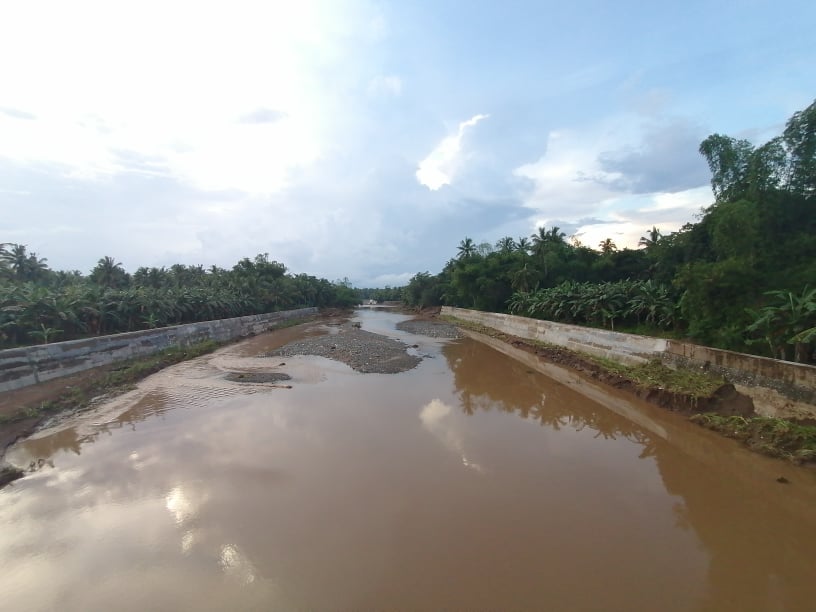
Languyon River in Tuburan town as seen on December 4, 2020, or two days after it overflowed last Wednesday, December 2, 2020, due to incessant rains. The river is Tuburan’s major tributary. | Photo by Morexette Marie Erram #CDNDigital
TUBURAN, Philippines — The town of Tuburan in northwestern Cebu experienced its worst floodings last Wednesday, December 2, 2020.
And the number of families affected, and the cost of damages on infrastructure and agriculture were feared to grow days after it occurred.
On Friday, December 4, 2020, the Cebu Provincial Government conducted a post-flooding assessment in three towns hit by last Wednesday’s severe floodings.
These are Balamban, Asturias and Tuburan.
Richard Hernandez, head of the Tuburan Municipal Disaster Risk Reduction and Management Office (MDRRMO), said a total of 20 barangays and around 2,200 households were affected by the recent floods.
There are 54 barangays in Tuburan.
He also said that they also estimated around P55 million worth of damages- P40 million in infrastructure and P15 million in agriculture in the town.
But as of December 4, Hernandez said they are still receiving information from barangays in relation to the disaster, and that the figures would still increase.
“We are anticipating the numbers to grow as the days progress because we’re still compiling all data from the barangays,” he explained in Cebuano.
Fortunately, there were no casualties reported in this second-class municipality located approximately 88 kilometers northwest of Cebu City.
“We are really hoping no lives were lost,” said Hernandez.
Most of the damaged infrastructures reported in Tuburan were footbridges, he said.
“In terms of agriculture, most of the crops damaged were bananas,” Hernandez added.
The state weather bureau earlier said that the heavy rains experienced in some parts of central Cebu last December 2 were due to the combined presence of two weather systems – the end of a frontal system and a low-pressure area (LPA) which hasn’t intensified into a tropical depression as of December 4.
Hernandez said it was the “worst flooding Tuburan has experienced for the past 40 years”.
Factors
According to the town’s top MDRRMO official, they believed that Tuburan’s geographical characteristics contributed to the floodings.
Hernandez said most of the villages which reported floodings were surrounded by rivers.
To recall, these rivers overflowed that led to floodwaters reaching neck-deep in some barangays.
“When you have a map, you can see that Tuburan’s rivers are shaped like a bottleneck. The flow of the waters going to the sea is slow and as a result, the volume inland will swell,” Hernandez explained.
He also said they are verifying reports that several water spouts (buhawi in Cebuano) in the mountain barangays contributed to the river levels to rise and overflow last December 2.
Governor Gwendolyn Garcia, in the meantime, led the distribution of relief packs to families affected by the floods in Tuburan town on December 4.
Garcia also expected several damaged flood-control infrastructures here and in the towns of Balamban, and Asturias.
Damaged flood-control projects
Last Wednesday’s heavy rains led both Balamban River and Guinabasan River, in Balamban and Asturias respectively, to swell.
As a result, portions of flood-control infrastructures constructed in both rivers suffered significant damages.
For Balamban, the Capitol and its local government are planning to conduct dredging operations in the Balamban River.
During the post-flooding assessment attended by Garcia, Balamban Mayor Alex Binghay, Cebu 3rd District Representative Pablo John Garcia, and Department of Public Works and Highways – Cebu 3rd District Engineering Officer, Engr. Daisy Toledo, it was agreed that dredging the town’s largest river, in terms of the volume of water flowing through it, is the “immediate solution” to address recent floodings there.
In Balamban, waist-deep floods were recorded in Barangays Nangka and Cantuod, which are located near the Balamban River./rcg

